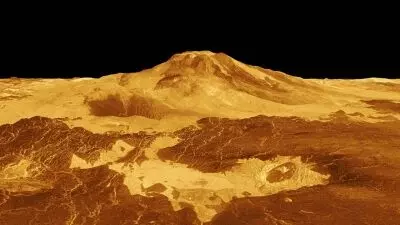
1st evidence of volcanic activity on Venus detected by scientists
text_fieldsWashington: For the first time, scientists have directly verified recent volcanic action on Venus' surface.
Archival radar images of Venus from the 1990s, taken more than 30 years ago by NASA's Magellan mission, were examined to make the finding.
Images showed a volcanic vent that had grown considerably in size and changed shape in less than a year.
"I didn't really expect to be successful, but after about 200 hours of manually comparing the images of different Magellan orbits, I saw two images of the same region taken eight months apart exhibiting telltale geological changes caused by an eruption," said Robert Herrick, Professor at the University of Alaska Fairbanks, who led the search of the archival data.
The geological changes on Earth's twin are detailed in the journal Science.
Herrick found that these changes occurred in Atla Regio, a vast highland region near Venus' equator that hosts two of the planet's largest volcanoes, Ozza Mons and Maat Mons.
The region has long been thought to be volcanically active, but there was no direct evidence of recent activity. While scrutinising Magellan radar images, Herrick identified a volcanic vent associated with Maat Mons that changed significantly between February and October 1991.
In the February image, the vent appeared nearly circular, covering an area of less than 2.2 sq km.
It had steep interior sides and showed signs of drained lava down its exterior slopes, factors that hinted at activity.
In radar images captured eight months later, the same vent had doubled in size. It also appeared to be filled to the rim with a lava lake.
Further, Herrick teamed up with Scott Hensley, a specialist in analysing radar data like Magellan's.
The two researchers created computer models of the vent in various configurations to test different geological-event scenarios, such as landslides.
From those models, they concluded that only an eruption could have caused the change.
"Only a couple of the simulations matched the imagery, and the most likely scenario is that volcanic activity occurred on Venus' surface during Magellan's mission," said Hensley. "While this is just one data point for an entire planet, it confirms there is modern geological activity."
The scientists liken the size of the lava flow generated by the Maat Mons activity to the 2018 Kilauea eruption on the Big Island of Hawaii.
NASA's new mission to Venus VERITAS aims to discover more volcanic activity on the planet.
VERITAS -- short for Venus Emissivity, Radio Science, InSAR, Topography, And Spectroscopy -- will study Venus from surface to core to understand how a rocky planet about the same size as Earth took a very different path, developing into a world covered in volcanic plains and deformed terrain hidden beneath a thick, hot, toxic atmosphere.
The mission will likely launch in a decade, NASA said.
With inputs from IANS
























